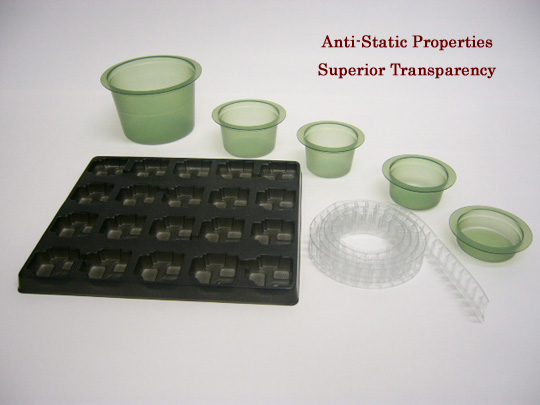
Our Plastics Molding Division is a recognized leader in Japan and the Pacific Rim for high quality products at equally competitive prices.
Our Vacuum Molding products are unique, with Anti-Static capabilities, as well as Electric Conductivity processes. This coupled with our superior film transparency, sets our Vacuum Molded products apart...from other manufacturers.
San-Ai would like to offer our long standing experience in the Plastics Molding field to our North American clients. We welcome your inquiriesc
Thermoforming
Thermoforming of plastic sheet has developed rapidly in recent years. This process consists of heating thermoplastic sheet to a formable plastic state and then applying air and/or mechanical assists to shape it to the contours of a mold.
Air pressure may range from almost zero to several hundred psi. Up to approximately 14 psi (atmospheric pressure), the pressure is obtained by evacuating the space between the sheet and the mold in order to utilize this atmospheric pressure. This range, known as vacuum forming, will give satisfactory reproduction of the mold configuration in the majority of forming applications.
Transfer Molding
Transfer molding is most generally used for thermosetting plastics. This method is like compression molding in that the plastic is cured into an infusible state in a mold under heat and pressure. It differs from compression molding in that the plastic is heated to a point of plasticity before it reaches the mold and is forced into a closed mold by means of a hydraulically operated plunger.
Transfer molding was developed to facilitate the molding of intricate products with small deep holes or numerous metal inserts. The dry mold compound used in compression molding sometimes disturbs the position of the metal inserts and the pins which form the holes. The liquefied plastic material in transfer molding flows around these metal parts without causing them to shift position.
Compression Molding
Compression molding is the most common method of forming thermosetting materials. It is not generally used for thermoplastics.
Compression molding is simply the squeezing of a material into a desired shape by application of heat and pressure to the material in a mold.
Plastic molding powder, mixed with such materials or fillers as woodflour and cellulose to strengthen or give other added qualities to the finished product, is put directly into the open mold cavity. The mold is then closed, pressing down on the plastic and causing it to flow throughout the mold. It is while the heated mold is closed that the thermosetting material undergoes a chemical change which permanently hardens it into the shape of the mold.
The three compression molding factors -- pressure, temperature and time the mold is closed -- vary with the design of the finished article and the material being molded.


